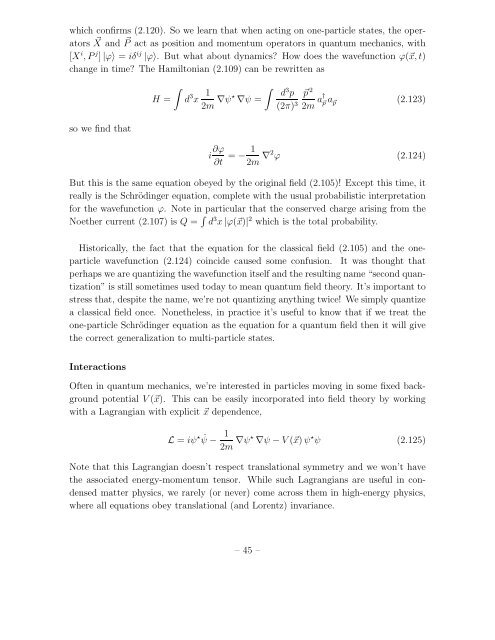Quantum Field Theory
Quantum Field Theory
Quantum Field Theory
Create successful ePaper yourself
Turn your PDF publications into a flip-book with our unique Google optimized e-Paper software.
which confirms (2.120). So we learn that when acting on one-particle states, the operators⃗ X and ⃗ P act as position and momentum operators in quantum mechanics, with[X i , P j ] |ϕ〉 = iδ ij |ϕ〉. But what about dynamics? How does the wavefunction ϕ(⃗x, t)change in time? The Hamiltonian (2.109) can be rewritten asso we find that∫H =d 3 x 1 ∫2m ∇ψ⋆ ∇ψ =d 3 p(2π) 3 ⃗p 22m a† ⃗p a ⃗p (2.123)i ∂ϕ∂t = − 12m ∇2 ϕ (2.124)But this is the same equation obeyed by the original field (2.105)! Except this time, itreally is the Schrödinger equation, complete with the usual probabilistic interpretationfor the wavefunction ϕ. Note in particular that the conserved charge arising from theNoether current (2.107) is Q = ∫ d 3 x |ϕ(⃗x)| 2 which is the total probability.Historically, the fact that the equation for the classical field (2.105) and the oneparticlewavefunction (2.124) coincide caused some confusion. It was thought thatperhaps we are quantizing the wavefunction itself and the resulting name “second quantization”is still sometimes used today to mean quantum field theory. It’s important tostress that, despite the name, we’re not quantizing anything twice! We simply quantizea classical field once. Nonetheless, in practice it’s useful to know that if we treat theone-particle Schrödinger equation as the equation for a quantum field then it will givethe correct generalization to multi-particle states.InteractionsOften in quantum mechanics, we’re interested in particles moving in some fixed backgroundpotential V (⃗x). This can be easily incorporated into field theory by workingwith a Lagrangian with explicit ⃗x dependence,L = iψ ⋆ ˙ψ − 12m ∇ψ⋆ ∇ψ − V (⃗x) ψ ⋆ ψ (2.125)Note that this Lagrangian doesn’t respect translational symmetry and we won’t havethe associated energy-momentum tensor. While such Lagrangians are useful in condensedmatter physics, we rarely (or never) come across them in high-energy physics,where all equations obey translational (and Lorentz) invariance.– 45 –
















